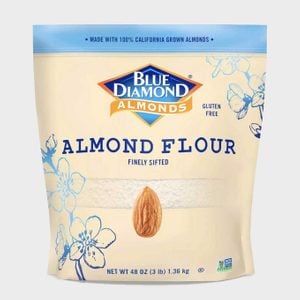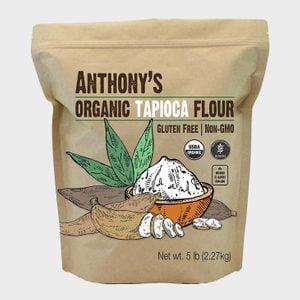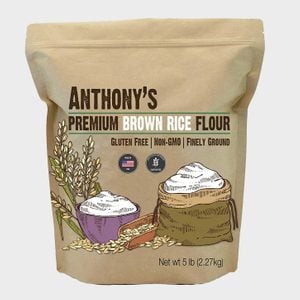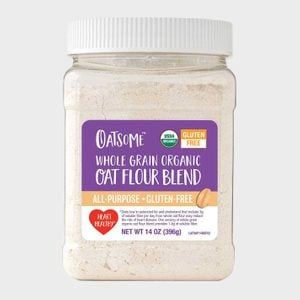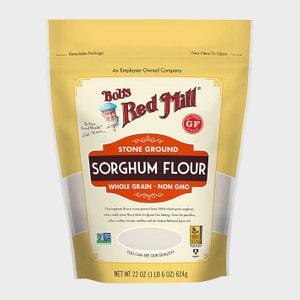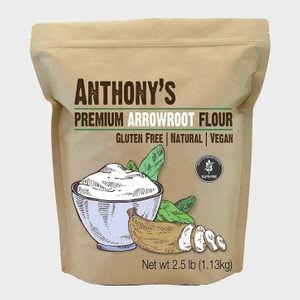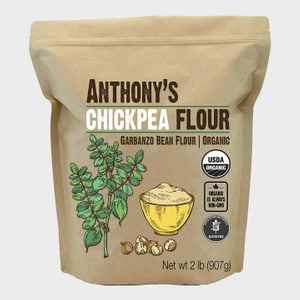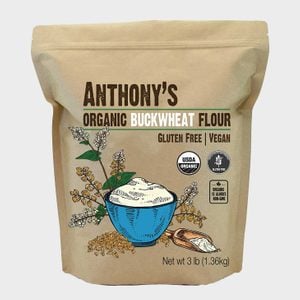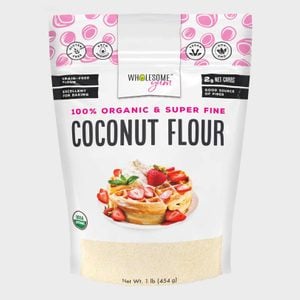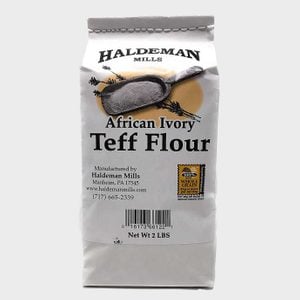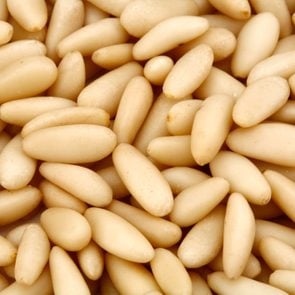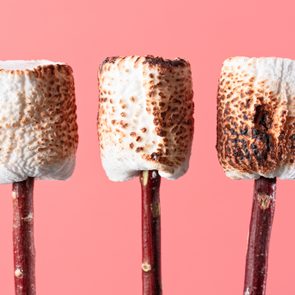What Is Gluten-Free Flour, Exactly?
Updated: Apr. 19, 2023

You don't need wheat for a delicious, easy-to-use baking ingredient. Learn more about the most popular gluten-free flours and how to cook with them.
If you have Celiac disease, eating anything with gluten, a type of protein found in certain cereal grains, can be dangerous to your health. That means food made with traditional flour is completely off the menu. But these days, it’s more than just people diagnosed with that autoimmune condition who avoid gluten and seek out foods made with gluten-free flour instead. Those of you interested in food facts may have these questions: What is gluten-free flour, and who else can benefit from using it?
Many people without a diagnosis of Celiac disease choose to cut or minimize gluten from their diet because they’re sensitive to it, says recipe developer Paola Anna Miget, creator of Stay Gluten-Free. Jeffrey Larsen, author of Gluten-Free Baking at Home, agrees, saying that some find they have better digestion when they don’t eat gluten. And others follow a gluten-free diet for weight-loss. Whatever the reason you avoid or minimize gluten, gluten-free flour (and foods made with it) should be a mainstay in your kitchen.
Similar to knowing the difference between bread flour and all-purpose flour, many people are confused about how gluten-free flour is different from all-purpose flour. If you still want to enjoy pizza and baked goods like cake, muffins and milk and cookies, it’s important to have all the intel about gluten-free living. Already think you’re a kitchen whiz? Maybe this food quiz will prove you right. If you make no claim to being a cooking pro, here’s what you need to know about gluten-free flour.
Get Reader’s Digest’s Read Up newsletter for more food facts, cleaning, travel, tech and humor all week long.
What is gluten-free flour?
Gluten-free flour is a type of flour made without gluten that is meant to replace all-purpose flour, says Miget. All-purpose flour is made from wheat—and wheat contains gluten. Gluten-free flour is made with ingredients other than wheat, such as different types of grains, nuts and seeds. Larsen says there are many different options.
Gluten-free flours differ from one another in terms of nutritional value, taste and texture. For this reason, the best gluten-free flour is different based on what you’re using it for and personal preference.
Gluten-free flour can replace regular flour wherever it is called for, says Miget. “But gluten-free flour is often not an exact 1:1 replacement. Gluten-free flours are often blends of flours, starches and sometimes gums that are mixed together in specific ratios to replace wheat flour.”
What is the difference between gluten-free flour and regular flour?
Gluten-free flour and regular flour differ because they are made from different ingredients. Regular flour (also called all-purpose flour) is made from wheat, and gluten-free flour does not contain wheat. Still wondering, Is flour gluten-free? The answer is a big, fat no.
Here’s another key difference between gluten-free flour and regular flour: Regular flour does not contain starches and gums. However, regular flour is typically enriched with nutrients including niacin, iron, folic acid and enzymes, which give baked goods a soft, doughy texture. Most gluten-free flours are not enriched.
Larsen says that even the best gluten-free flours differ slightly in taste and texture from regular flour. “Gluten gives food a sort of rubbery component, a really beautiful property that makes food slightly sticky and chewy,” he says. While using gluten-free flour in place of regular flour won’t give you exactly the same texture and taste, he notes, there’s no shortage of delicious foods you can make with it.
What is a gluten-free flour blend?
Miget explains that the vast majority of the time, different gluten-free ingredients are combined to make a gluten-free flour blend. Single-grain gluten-free flours are aplenty, but you will probably need to combine it with another gluten-free flour when cooking or baking. Mixing different types of flour helps your baked goods have the ideal texture and flavor.
What types of flours are gluten-free?
There are so many brands of gluten-free flours on the market. “The products available to the gluten-free community these days are so much more than when I started my gluten-free journey 20 years ago,” Miget says. Here are the 10 different types of gluten-free flours, with details on how they’re made and how they’re best used.
Almond flour
Is almond flour gluten-free? Yes, it is. As you can likely gather from its name, almond flour is made from ground, blanched almonds. The almonds are boiled in water and then ground down until they have a flour-like consistency. “Nut flours like almond flour have really beautiful moisture and mouthfeel,” Larsen says. He adds that almond flour pairs well with yeast and is best used to make foods such as pizza dough (yes, we’re talking about pizza again) and bread or other foods that would taste great with a slightly nutty taste. Just be aware that different types of flour have different expiration dates, and nut flours can go bad in just a few months. Blue Diamond Almond Flour is a popular option.
Tapioca flour
Tapioca flour is made from cassava root, a South American starchy root vegetable also known as manioc or yuca. First, the cassava root is peeled and chopped. Then it’s combined with water and shredded into a fine powder. Larsen says tapioca flour is one of his go-tos, which he blends with potato starch. Together, he says, the texture is light and fluffy. This makes it ideal for cakes and cupcakes. On its own, tapioca flour is stretchier and stickier, properties that can be ideal when making savory, cheesy foods. Anthony’s Organic Tapioca Flour Starch is a solid choice.
Rice flour
Another common gluten-free flour, rice flour can be found in both white rice and brown rice varieties. It’s made by blending uncooked rice until it’s a fine powder. Anthony’s Premium Brown Rice Flour gets rave reviews. This can also be done at home using a blender, food processor or coffee grinder. Rice flour is versatile because it doesn’t have much taste, Larsen says, so it can be used in a wide range of recipes for both savory and sweet foods.
Oat flour
As with the other types of flour, oat flour is made by grinding uncooked oats into a fine powder. Like rice flour, this can also be done at home using a food processor, blender or coffee grinder. Just like with oats in their whole form, oat flour has a neutral, mild taste and can be used in a wide variety of recipes. Try Oatsome Oat Flour Blend the next time you’re making cookies.
Sorghum flour
Sorghum is a type of gluten-free cereal grain that can be ground up and turned into sorghum flour. It has traditionally been used to make flat, gluten-free breads. When using sorghum flour, it’s important to also use a binding agent, such as xanthan gum, or your ingredients won’t combine together well. Check out Bob’s Red Mill Sorghum Flour.
Arrowroot flour
Made from a root vegetable that’s native to Indonesia, arrowroot also can be ground up and transformed into flour. Not familiar with it? “Arrowroot flour is very similar to tapioca flour,” Miget says. It has a neutral taste and can be used in both savory and sweet cooking and baking. Believe it or not, arrowroot powder can also be used as an egg substitute. Anthony’s Premium Arrowroot Flour works well for sauces and gravies.
Chickpea flour
You’ve likely had chickpeas, also known as garbanzo beans, in the form of hummus, but chickpeas can be ground up into a gluten-free flour too. As you can likely guess, chickpea flour does have a bean-y flavor, so this type of flour is best used in savory dishes and not baked goods. One benefit of using chickpea flour is that it’s higher in protein than other types of gluten-free flour. Anthony’s has another great option for chickpea flour.
Buckwheat flour
Buckwheat is a completely different gluten-free cereal grain that can be ground into flour. “Despite its name, buckwheat flour does not actually contain wheat,” Larsen says. Buckwheat flour is highly acidic and pairs well with spices like ginger, cinnamon and nutmeg. “It would be a great one to use if you’re making ginger pancakes or ginger cookies,” he adds. Try Anthony’s Organic Buckwheat Flour when you’re in a gingery mood.
Coconut flour
Coconut flour is made by grinding up dried coconut meat. It’s less commonly used than the other gluten-free flours on this list, but you may see it on a recipe ingredients list or recommended to use in conjunction with another gluten-free flour. Coconut flour is higher in protein and fiber than all-purpose flour, so using it as a substitute adds nutritional value to your food. It also has a light texture and is slightly sweet, making it great to incorporate into baked goods. Wholesome Yum Organic Coconut Flour does the trick.
Teff flour
This one may be completely off your radar. Teff is a gluten-free cereal grain traditionally grown in Ethiopia, and it can be ground up and used as a gluten-free flour. It’s especially good to use when brewing beer. (Yes, beer typically has gluten!) It can also be used to make gluten-free pasta or bread. Try Haldeman Mills African Ivory Teff Flour if you want to bake or brew.
How to bake with gluten-free flour
With these expert tips, you’ll be wishing you could compete in the Great British Baking Show.
Stock your pantry with more than one type
Both Miget and Larsen reiterate that the vast majority of the time, gluten-free recipes will call for more than one type of gluten-free flour. This is why the blended products are useful for people who are new to gluten-free living. Gluten-free recipes should specify which gluten-free flours to use and what the measurements should be.
Look for gluten-free recipes
And there are a lot of them. “When baking with gluten-free flour, the flour you use will make all the difference in your recipe,” Miget says. She emphasizes that one cup of all-purpose flour blend is not equal to one cup of gluten-free flour or gluten-free flour blend. “Since gluten-free flours are compiled of different ingredients, these ingredients do not all weigh the same. This is another reason why gluten-free flours cannot be used interchangeably.” Seek out recipes where the chefs or bakers know the gluten-free flour used will complement the other ingredients.
Have fun experimenting
It’s time to have some experimental fun in the kitchen! “Gluten-free flours are whole new ingredients to play with, and each one has its own unique properties,” Larsen says. American culture is very wheat-centric, so consider them another tool in your pantry—and a versatile and delicious one at that.
Now that you know what gluten-free flour is and how to use it, uncover more kitchen mysteries, including what white chocolate is and what vanilla flavoring is made from.
Sources:
- Paola Anna Miget, recipe developer and creator of Stay Gluten-Free
- Jeffrey Larsen, author of Gluten-Free Baking at Home



















